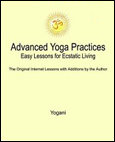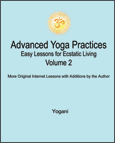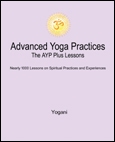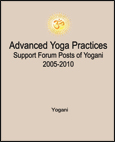|
Public Home | Plus Home | Main Lessons | Tantra Lessons | Public Forum | Plus Forum | Downloads | Books Topic Paths | Search | Training-Retreats | Testimonials | Survey | Interviews | MultiMedia | Contact | Donate |
|
Advanced Yoga Practices Note: For the Original Internet Lessons with additions, see the AYP Easy Lessons Books. For the Expanded and Interactive Internet Lessons, AYP Online Books, Audiobooks and more, see AYP Plus. Lesson 384 - Baseline Systems of Practice and Research on Modifications (Audio)
AYP Plus Additions:
From: Yogani New Visitors: It is recommended you read from the beginning of the web archive, as previous lessons are prerequisite to this one. The first lesson is, "Why This Discussion?"
The AYP system of practices is a "baseline" that can be used as a stand-alone approach for cultivating human spiritual transformation, or to supplement any other approach with components of practice that may add to the overall effectiveness of any spiritual path. While the AYP system may at times seem to be immovable and monolithic, it is not intended to be that. It is intended to be an effective foundation of practices that can be adapted according to individual needs. If AYP is not working as it should be, even with self-pacing, then modifications and alternatives should be considered. When this is done, it is very helpful to share the results so many might benefit from our collective experience. This is what the AYP online forums and community are for. There are endless variations on practice, and it is not possible to cover them all in one core teaching while maintaining a cohesive baseline at the same time. And it is not possible for one person to cover every conceivable variation on practice either. However, as a community of practitioners, we can look at many experiences across a wide spectrum and tweak applications of the baseline according to individual need. For self-directed practice, this is a viable model going forward - a baseline with flexibility according to each individual situation. This is essentially what self-pacing is about - individually adjusting our practice times to fine-tune results for good progress with comfort. It also applies to variations in the nature of the practices themselves, as we have discussed in the lessons on under-sensitive and over-sensitive meditators (see Lessons 365-367). Note: Increasing AYP Spinal Breathing Pranayama, Deep Meditation or Samyama more than 5-10 minutes above the baseline times shown in Lesson 385, or increasing any of the AYP energy-related practices shown there more than 5 minutes, could lead to uncomfortable symptoms of overdoing. Such excessive additions would be outside the AYP baseline system, and the practitioner's experiment. While a baseline system of practice may be useful to many, we should always be careful about the "stature" we assign to it, or to the one who has devised it. The perception of stature tends to undermine independent exploration and innovation. At its worst, undue stature leads to a belief-culture of "haves" and "have-nots," also known as "sectarianism," which is a great obstacle to progress. That is why I hope the concepts of "horizontal transmission" and "peer-to-peer" sharing of knowledge will always be associated with AYP. On the other hand, doing independent exploration and innovation is not about trying 50 things in rapid succession and benefiting little from any of them. Neither is it about adding excessive variations and complexity into a baseline system whose purpose is to provide simple and effective means for practitioners to activate the essential principles of human spiritual transformation. Upon such basics, and a stable daily routine of practice, the explorations and modifications can occur in a careful and fruitful way, not much before. Beginners deserve some clarity. This is why I always suggest newcomers review the AYP writings before delving too much into variations on practice, other than self-pacing as needed. In spiritual matters, less is usually more, and it is up to each of us to craft our own approach in concert with our unique process of purification and opening. Proposed modifications and alternative approaches have been plentiful since AYP began in 2003, in great mountains in my email, and similarly in the online support forums ever since they started. Many times, modifications, alternatives, and even entire alternate systems have sought validation from me, the community of practitioners, or from the AYP system itself, sometimes to the point of insisting that the baseline AYP system be rewritten to suit! This is a tricky business, because a practice or system of practices seeking external validation is often doing so at the expense of finding its own internal validation through direct experience and the observation of cause and effect. With the latter, no validation from outside is necessary. Once shared, the results will be self-evident to many. So there is no need to seek external validation, or to cram anything down anyone's throat. If we share our explorations and experiences openly and honestly, letting go of the need for external validation, then some practitioners will resonate with what we share and others will not. That is how it is, even for the AYP system. One size does not fit all. So, we begin with the basics and go from there, connecting with knowledge, practices and experiences in ways that best suit our nature. We will know it when we see it. Everyone who engages in self-directed spiritual practices is a researcher in consciousness. In the past, this has been a lonely profession, reserved for the few, often done in secret, with little shared with the general population. For those who wanted access, a pledge of body, soul and bank account was often required. For this reason, much of spiritual knowledge has been called arcane and esoteric. Perhaps there were good reasons. Knowledge was not very portable in centuries past, and there was much superstition surrounding the process of human spiritual transformation. Even those who spoke clearly about it did not find a large audience. It is only through the centuries that recorded knowledge on spiritual practices has slowly become more accessible and utilized more widely. In our time, we have a great opportunity. This is the information age, and we are in the midst of an explosion of applied knowledge in all fields of human endeavor. It is happening in the field of human spiritual transformation also. Now we have open access to many more practices, and are in the process of integrating and applying the means that directly cultivate purification and opening within us on an accelerated scale. The eight limbs of yoga, presented by Patanjali centuries ago, are no longer only a list of the possibilities and interrelationships of practices and experiences, but are also a list which we can apply using real resources for transformation. We are expanding from the philosophical into the practical, and every day is a learning experience by which we can make adjustments in practices leading to ever more direct knowledge of who and what we are. The journey we each are on is our research, and it should be shared. In this way, we can find out what we have in common in our development and what may be divergent from the norm. In fact, we are finding the divergences to be less than have been believed. The divergences have been mostly man-made. The human nervous system is the same everywhere, and the principles and capabilities for purification and opening to divine experience are also the same. So what do we not have in common? Perhaps our culture and religion, and the variations in methods that have been handed down to us. But, in the end, we are all working on the same project, no matter where we have come from or what tools we are using. Our inner obstructions (karma) may vary, but the means for purifying and opening our nervous system are essentially the same. The eight limbs of yoga cover the full range, and if we are focused in one limb, we will surely find the others through the connectedness of yoga, alive within us. By practicing daily, self-pacing, and open sharing, the truth will continue to emerge in modern times. This is the road to the future. It is in our hands to sustain the advance of applied spiritual science for all time. There are plenty of spiritual pioneers emerging these days who are marching forward with the systematic application of spiritual practices in ways that have not been tried before. Modern institutions of research and higher learning will catch on eventually, and then lead the way in thoroughly researching the methods of human spiritual transformation, supported by an ever-growing segment of the population engaged in daily practices. Why will the institutions eventually take the lead? Because there are great issues of the public welfare at stake - the health, well-being and happiness of all the nations and cultures of the world. As we unfold the full potential of the individual, so too will we unfold the full potential of societies everywhere around the world. Just as industrial and information technologies have changed life on earth, so too will spiritual technologies enhance the quality of life everywhere. This is why the large institutions will become deeply involved in uncovering the specific mechanisms of human spiritual transformation, and the means for optimizing them on every level. As in all other fields of human endeavor, ongoing research and development for the practical application of spiritual knowledge will carry us forward to a quality of life we can scarcely imagine today. It all has been contained in seed form within each of us. Now we are bringing our full potential to fruition, and everyone will share in this. This will not be knowledge based on the charismatic personalities that have come and gone in every generation. Rather, it will be knowledge applied by each of us, recorded and continuously evolving to more efficient applications, which can be verified, improved upon, and utilized in practical ways by everyone for generations to come. It is the truth we are looking for here. The AYP system can be a useful baseline, but it is not going to be the perfect answer for everyone in every time. This is true of every system of spiritual practice. The key is ongoing research and development of practical knowledge, based on real time cause and effect. The guru is in you.
Discuss this Lesson in the AYP Plus Support Forum Note: For detailed instructions on building a daily practice routine with self-pacing, see the Eight Limbs of Yoga Book, and AYP Plus. |
|
|
|
Join the Mail List:
AYP Retreats
eBooks - PDF, EPUB
FREE eBooks with
SAVE with Bundled
|

























